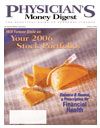Publication
Article
Physician's Money Digest
Beware the Costs of Hedging with Annuities
Author(s):
I am currently working with aphysician, whom I will call Dr.Jones, who started a defined benefitpension plan a few yearsback. When he discussed investmentstrategy for his contributions tothe plan, Dr. Jones told his financialadvisor that he wanted to make surethat he wouldn't lose any of it.
Complete with bells and whistles, hisadvisor recommended a fancy variableannuity, which guaranteed that Dr.Jones would be able to withdraw atleast as much money as he contributesover time, no matter how poorly theinvestments do. If they do well, he couldwithdraw the higher value of the annuityportfolio. This sounded just right toDr. Jones, and he invested a good partof his contributions in this annuity.
I will not belabor the point that itrarely makes sense to put a tax-deferredvehicle like a variable annuity inside atax-deferred account. Also when all issaid and done, the built-in costs of variableannuities are so high that mostpeople should not buy into them, evenin taxable accounts. The insurancecompanies recognize these problems,and this type of variable annuity playson our desire to avoid risk.
Worthless Guarantees
In this case, Dr. Jones did not understandthat he will pay close to 3.5% inannual fees and expenses on this annuity,which is at least 3% higher than theannual cost of a good index or exchange-traded fund. For these outrageousfees, Dr. Jones did get the guaranteedwithdrawals I described above,which are almost worthless. Here's why.
Even if he could withdraw anamount equal to his contributions over20 years, the buying power of thatamount will be much less than the buyingpower of what he contributes overthe years because of inflation. So, whenmeasured in terms of buying power, Dr.Jones may still lose money.
Moreover, if the value of the portfolioat the time withdrawals are taken is lessthan his total contributions, then Dr.Jones will be allowed to withdraw themoney only over a 10-year period.During that time, the stock market willmost likely recover and the insurancecompany will not have to make good onanything from its own pocket. Finally,the stock market almost never losesmoney, especially in nominal terms, overlong stretches like 20 or 30 years.
Costly 3% Difference
For a 3% annual fee, Dr. Jonesbought protection against the very lowprobability (say, a 5% chance) that thestock market will lose value over 30years. And what is the true cost of the3% annual fee over a 30-year period? Ifyou invest $100,000 for 30 years andearn a 10% annual return, you willhave $1.7 million. If you pay 3% inexcess fees, which will reduce yourreturn to 7% per year, you will accumulateonly about $760,000. Dr. Jones willforego close to $1 million, or more thanhalf of his potential return over time, tohedge a very low-probability loss.
You have to take some risk, buthedging all risks is very expensive.Because you are not knowledgeableabout assessing and pricing risk, ifyou buy hedge funds from expertslike insurance companies and do nothave a knowledgeable financial advisorwho is on your side, you may payan exorbitant price for an essentiallyworthless hedge.
Chandan Sengupta, author of The Only
Proven Road to Investment Success (John
Wiley; 2001) and Financial Modeling Using
Excel and VBA (John Wiley; 2004), currently
teaches finance at the Fordham University
Graduate School of Business and consults with individuals
on financial planning and investment management. He welcomes
questions or comments at chandansen@aol.com.
